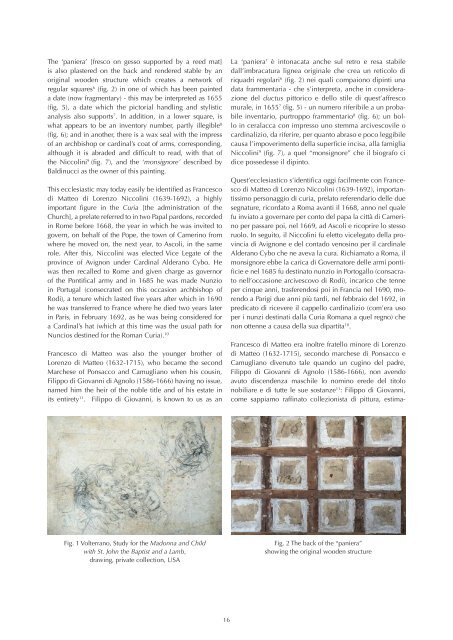Baldassarre Franceschini Il Volterrano - Jean Luc Baroni
Create successful ePaper yourself
Turn your PDF publications into a flip-book with our unique Google optimized e-Paper software.
The ‘paniera’ [fresco on gesso supported by a reed mat]<br />
is also plastered on the back and rendered stable by an<br />
original wooden structure which creates a network of<br />
regular squares 6 (fig. 2) in one of which has been painted<br />
a date (now fragmentary) - this may be interpreted as 1655<br />
(fig. 5), a date which the pictorial handling and stylistic<br />
analysis also supports 7 . In addition, in a lower square, is<br />
what appears to be an inventory number, partly illegible 8<br />
(fig. 6); and in another, there is a wax seal with the impress<br />
of an archbishop or cardinal’s coat of arms, corresponding,<br />
although it is abraded and difficult to read, with that of<br />
the Niccolini 9 (fig. 7), and the ‘monsignore’ described by<br />
Baldinucci as the owner of this painting.<br />
This ecclesiastic may today easily be identified as Francesco<br />
di Matteo di Lorenzo Niccolini (1639-1692), a highly<br />
important figure in the Curia [the administration of the<br />
Church], a prelate referred to in two Papal pardons, recorded<br />
in Rome before 1668, the year in which he was invited to<br />
govern, on behalf of the Pope, the town of Camerino from<br />
where he moved on, the next year, to Ascoli, in the same<br />
role. After this, Niccolini was elected Vice Legate of the<br />
province of Avignon under Cardinal Alderano Cybo. He<br />
was then recalled to Rome and given charge as governor<br />
of the Pontifical army and in 1685 he was made Nunzio<br />
in Portugal (consecrated on this occasion archbishop of<br />
Rodi), a tenure which lasted five years after which in 1690<br />
he was transferred to France where he died two years later<br />
in Paris, in February 1692, as he was being considered for<br />
a Cardinal’s hat (which at this time was the usual path for<br />
Nuncios destined for the Roman Curia). 10<br />
Francesco di Matteo was also the younger brother of<br />
Lorenzo di Matteo (1632-1715), who became the second<br />
Marchese of Ponsacco and Camugliano when his cousin,<br />
Filippo di Giovanni di Agnolo (1586-1666) having no issue,<br />
named him the heir of the noble title and of his estate in<br />
its entirety 11 . Filippo di Giovanni, is known to us as an<br />
La ‘paniera’ è intonacata anche sul retro e resa stabile<br />
dall’imbracatura lignea originale che crea un reticolo di<br />
riquadri regolari 6 (fig. 2) nei quali compaiono dipinti una<br />
data frammentaria - che s’interpreta, anche in considerazione<br />
del ductus pittorico e dello stile di quest’affresco<br />
murale, in 1655 7 (fig. 5) - un numero riferibile a un probabile<br />
inventario, purtroppo frammentario 8 (fig. 6); un bollo<br />
in ceralacca con impresso uno stemma arcivescovile o<br />
cardinalizio, da riferire, per quanto abraso e poco leggibile<br />
causa l’impoverimento della superficie incisa, alla famiglia<br />
Niccolini 9 (fig. 7), a quel “monsignore” che il biografo ci<br />
dice possedesse il dipinto.<br />
Quest’ecclesiastico s’identifica oggi facilmente con Francesco<br />
di Matteo di Lorenzo Niccolini (1639-1692), importantissimo<br />
personaggio di curia, prelato referendario delle due<br />
segnature, ricordato a Roma avanti il 1668, anno nel quale<br />
fu inviato a governare per conto del papa la città di Camerino<br />
per passare poi, nel 1669, ad Ascoli e ricoprire lo stesso<br />
ruolo. In seguito, il Niccolini fu eletto vicelegato della provincia<br />
di Avignone e del contado venosino per il cardinale<br />
Alderano Cybo che ne aveva la cura. Richiamato a Roma, il<br />
monsignore ebbe la carica di Governatore delle armi pontificie<br />
e nel 1685 fu destinato nunzio in Portogallo (consacrato<br />
nell’occasione arcivescovo di Rodi), incarico che tenne<br />
per cinque anni, trasferendosi poi in Francia nel 1690, morendo<br />
a Parigi due anni più tardi, nel febbraio del 1692, in<br />
predicato di ricevere il cappello cardinalizio (com’era uso<br />
per i nunzi destinati dalla Curia Romana a quel regno) che<br />
non ottenne a causa della sua dipartita 10 .<br />
Francesco di Matteo era inoltre fratello minore di Lorenzo<br />
di Matteo (1632-1715), secondo marchese di Ponsacco e<br />
Camugliano divenuto tale quando un cugino del padre,<br />
Filippo di Giovanni di Agnolo (1586-1666), non avendo<br />
avuto discendenza maschile lo nomino erede del titolo<br />
nobiliare e di tutte le sue sostanze 11 : Filippo di Giovanni,<br />
come sappiamo raffinato collezionista di pittura, estima-<br />
Fig. 1 <strong>Volterrano</strong>, Study for the Madonna and Child<br />
with St. John the Baptist and a Lamb,<br />
drawing, private collection, USA<br />
Fig. 2 The back of the “paniera”<br />
showing the original wooden structure<br />
16
















